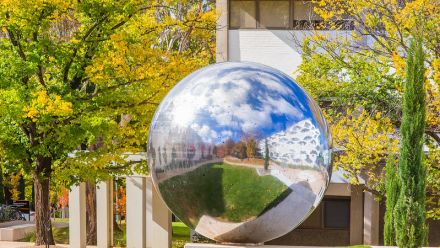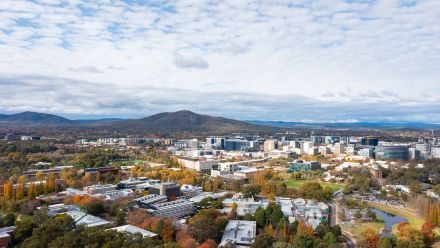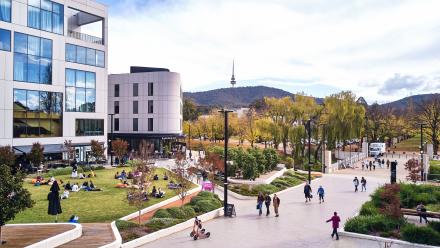ANU Spaces - Waratah Lahy
Meet Waratah Lahy, the University’s Outreach Coordinator at the ANU School of Art. One of her main roles is overseeing the School’s Emerging Artist Support Scheme.
Waratah, what do you do at ANU?
I work at the School of Art and my main job is the Outreach Coordinator, which means that I organise a lot of the art programs here at the School – the lunchtime lectures, which we have running throughout the semester. We also have evening talks. I also do other jobs in that outreach bracket. We get school groups coming through the Art School. So we get year 12 students and year 10 students and hopefully next year primary school students. We’re getting them to do workshops and meet teachers. I’m also a sessional lecturer in the Painting Workshop and sometimes I teach life drawing through the Centre for Continuing Education and I also organise the Emerging Artists Support Scheme.
What is your favourite spot on campus?
Near the Chifley Library, walking to the Co-op Bookshop. So it’s a little bit of a walk from the Art School to the Co-op Bookshop. It’s a very nice, quick walk.
You like it because…
Sometimes it’s just nice seeing those kids playing Quidditch outside Chifley and there’s also very nice Banksia trees outside the Pauline Griffin Building. It’s just nice seeing different activities on the grass, what people are doing.
If you were free for an afternoon, you would…
I would go to the galleries. I’d go to the Drill Hall Gallery, I’d go to the School of Art Gallery, and actually we have a really fantastic library here at the School of Art with amazing monographs and art books. I’d browse the shelves for a while.
What is the Emerging Artists Support Scheme (EASS)?
The Emerging Artist Support Scheme, we call EASS for short. David Williams, who used to be the head of the Art School, established it about 20 years ago. And he initially asked different local businesses to become involved. So there was KPMG, Bradley Allen Love among others. And so they came along and acquired work for their own collections. We also used to have a borrowing scheme where patrons would come along and borrow work for a year at a time. So some of those patrons are still involved. We still have lots of businesses and private collectors who buy work for their personal collections. But we also have a lot of art organisations involved and they give out residencies and exhibitions. We also have business people who give out materials awards. Some people give out subscriptions to magazines and other people give cash awards and offer scholarships. So it’s really multi-pronged scheme that we run.
What do you mean by materials awards?
Some of our patrons include Eckersleys, who select a student to win a gift card to go into their stores to purchase any art materials that they want. Another business owner is Thor from Thor’s Hammer, and he gives out a materials award to a furniture or sculpture student, so they can go along to his business and get a whole heap of timber to use for making some projects.
How does the EASS help students at the School of Art?
EASS is a really fantastic way to get people started in their careers as artists. I know when I finished Art School, I got honours and the University medal, I did all of that. And then I went wow I’m qualified to be a waitress! And I was lucky enough to get some of the awards. And it’s the same for our students who have finished now. You have a really practical way of taking those first steps to becoming an artist. So it’s an enormous help if somebody’s already offering you an exhibition or a residency because it’s very difficult to be a student one day or be a small business the next. So if you don’t have to make those first steps of lining up an exhibition or finding a workspace that can be really helpful.
How does the scheme go about awarding different students?
I think one of the good things is awards are very much chosen by our patrons. So every year I provide patrons who want it with a list of recommended students for their award. That list of recommendations will be put to me by all of the heads of workshop. So they will try and nominate all of the students whom they think have done very well. But then patrons come around and have a look and it’s really up to them. They might choose work that isn’t to my aesthetic or isn’t to my taste but is really right for them. So it’s very much about rewarding all different types of students. It’s not just people who achieve really well on paper. It might be people who have got a bad honours score but have made artwork that the patrons respond to and who really want to support that. So it’s not just about grades and achievement, it’s what you’ve produced.
What is one of the most rewarding aspects of your job at ANU?
I have a soft spot for the Art School. I did my degree here and did other things and came back then did a PhD here as well and I’ve just stayed because as an artist it’s really fantastic working in this environment. I’m a practicing artist as well and it’s great. I love the quality of artists who come through here, and all the visiting artists who are exposed to different practices from all around the world. It’s really great for me, but it’s also really rewarding working somewhere where I may not teach students year after year but I might meet them at different points in their degree. And then running EASS I get to say ‘excellent, I taught that student when they’re in second year and now they’re getting this prize and its really great seeing what they’re doing.’ So it’s definitely an exciting and rewarding place to work.
As an artist, what medium do you work in?
I paint and I exhibit quite often and I’m represented by a gallery in Sydney called Brenda May. I just had a solo show there a few months ago. I’ve also exhibited in lots of group shows. I tend to focus on everyday moments that are unseen and overlooked. So it might be something small like the way sunlight hits a window and makes a really interesting pattern on a blind or you might see somebody walking out of a door. Just little things that seem a little bit banal but when you look at them you go ‘oh that’s actually really beautiful and moving.’ And I’m painting bigger now. In the past I’ve painted with a lot of interesting materials like bottle tops and painted scenes inside glasses so like snow domes.
What would you say to prospective students who are looking at studying at the School of Art?
I think it’s a no-brainer. You should come and study at the School of Art. Our staff here are fantastic and any teaching staff here, they all have to be practicing artists here themselves, so they’ve got very strong skills in their own areas. But it’s also, in practical terms, what students get access to. They get access to workshops. Many of the students have their own workspaces where they can, after first year, leave their work in their own space and work til 10 at night or whenever security kicks them out. We’ve got the galleries here, the art program, the Drill Hall Gallery and just around ANU and the local Canberra area there’s a really vibrant arts scene. So there’s a lot to tap into while you’re here.


